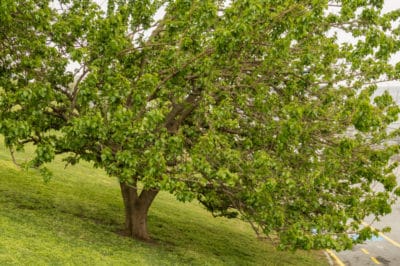The Leaves Tell the Tale
Black mulberry leaves are single, lobed leaves, without smaller leaves attached to the same stem. They are similar to the elm in that edges are irregular, rather than smooth, and feature a “hills and valleys” appearance. These single, lobed, irregular leaves are the first sign that you’re looking at a black mulberry tree. However, keep in mind that the leaves are not balanced in appearance; those irregular edges are also asymmetrical.
The red and white mulberry leave is more of an oval with a rounded-tooth edge and a definite point to the tip of the leaf.
Each Variety has a Special Feature, Too
- When examining the tree’s leaves, notice the base. Is the leaf somewhat short and the base shaped like a heart? If so, it’s probable that you’re looking at a black mulberry tree.
- If the leaf’s edge features rounded “teeth,” you’ve got either a red or a white mulberry.
- The white mulberry’s leaves are quite shiny, the leaves of the red mulberry aren’t quite as glossy.
- If your mulberry leaf is covered in dense hair, then you’re dealing with a paper mulberry.
Other Signs Can Confirm Your Identification
The black mulberry, Morus nigra, has leaves that are noticeably thicker than the leaves of other varieties of the tree. A stack of ten mature leaves, compressed between your fingers, should measure about 5/32 inch (4 millimeters), whereas the same quantity of another mulberry’s leaves would be about half as thick.
Black and red mulberry leaves tend to have a sandpapery feel to their surfaces while white mulberry leaves are smoother.
The white mulberry’s branches are noticeably straight and long, more so than the other types of mulberry. The branches of the black mulberry have an almost arthritic appearance; when the tree begins to awaken in spring, it features large nodes spaced fairly closely together.
The buds of the red mulberry are relatively flat and large; the white mulberry’s buds are more rounded in their centers, and somewhat smallish. In addition, the twigs on a red mulberry tree are a pale tan color. The twigs of the white mulberry are a pinkish-brown shade.
